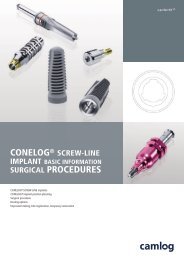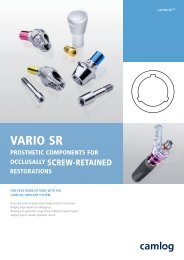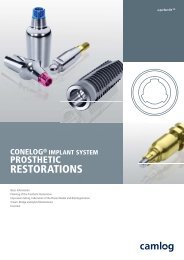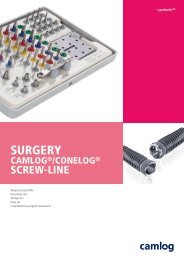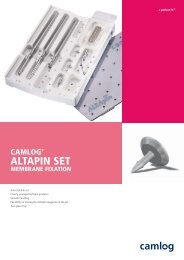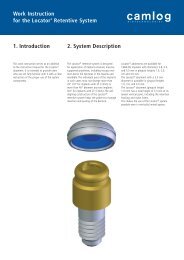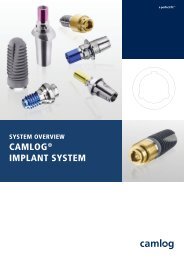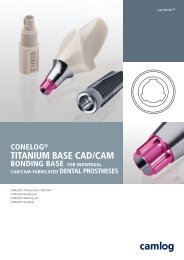Hybrid Restorations with the CAMLOG Implant System (PDF
Hybrid Restorations with the CAMLOG Implant System (PDF
Hybrid Restorations with the CAMLOG Implant System (PDF
Create successful ePaper yourself
Turn your PDF publications into a flip-book with our unique Google optimized e-Paper software.
HYBRID RESTORATIONS WITH THE <strong>CAMLOG</strong> ® IMPLANT SYSTEM<br />
LOCATOR ®<br />
ANCHORING SYSTEM<br />
RELINING OF A LOCATOR ® -RETAINED<br />
FULL DENTURE<br />
The colored replacement males are removed from <strong>the</strong> titanium housings in<br />
<strong>the</strong> denture and replaced by black processing replacement males using <strong>the</strong><br />
Locator ® instrument. See also "Exchange <strong>the</strong> replacement males in an existing<br />
full denture" on page 61.<br />
The processing replacement males fix and hold <strong>the</strong> denture during <strong>the</strong><br />
relining impression on <strong>the</strong> <strong>CAMLOG</strong> ® Locator ® abutments.<br />
The impression is taken <strong>with</strong> <strong>the</strong> denture in <strong>the</strong> conventional manner. Pay<br />
attention to <strong>the</strong> proper seating of <strong>the</strong> denture. Impression material must<br />
not get into <strong>the</strong> processing replacement males. After <strong>the</strong> impression is taken<br />
successfully, <strong>the</strong> black processing replacement males remain in <strong>the</strong> titanium<br />
housings of <strong>the</strong> denture. The relining impression is handed over to <strong>the</strong><br />
dental laboratory.<br />
62<br />
NOTE<br />
To select <strong>the</strong> matching Locator ® analogs for cast fabrication, <strong>the</strong> dental<br />
laboratory must be informed about <strong>the</strong> diameter of <strong>the</strong> existing<br />
<strong>CAMLOG</strong> ® Locator ® abutments.<br />
In <strong>the</strong> dental laboratory, <strong>the</strong> respective Locator ® analogs are inserted in <strong>the</strong><br />
black processing replacement males for cast fabrication (see also "Cast<br />
fabrication" on page 57).<br />
The cast is <strong>the</strong>n fabricated and <strong>the</strong> relining impression is secured in <strong>the</strong><br />
conventional manner.<br />
NOTE<br />
We recommend replacing <strong>the</strong> existing titanium housings in <strong>the</strong> denture.<br />
After opening <strong>the</strong> secured relining impression and removing of <strong>the</strong> impression<br />
from <strong>the</strong> cast, <strong>the</strong> black processing replacement males incl. <strong>the</strong> titanium<br />
housings are removed from <strong>the</strong> denture. The white block out spacers<br />
are placed over <strong>the</strong> functional areas of <strong>the</strong> Locator ® analogs on <strong>the</strong> cast.<br />
This prevents acrylic from getting into <strong>the</strong> titanium housings.<br />
A titanium housing <strong>with</strong> <strong>the</strong> black processing replacement male is placed<br />
on each analog over <strong>the</strong> previously placed block out spacer until <strong>the</strong> pressure<br />
point is reached. The titanium housing is attached by <strong>the</strong> black processing<br />
replacement males and <strong>the</strong> resilience determined.<br />
Titanium housing <strong>with</strong> black<br />
processing replacement males<br />
NOTE<br />
Undercuts between <strong>the</strong> titanium housings and <strong>the</strong> surrounding tissue<br />
not covered by <strong>the</strong> block out spacers must be blocked out. Acrylic must<br />
not get into <strong>the</strong> titanium housings when finishing!<br />
The denture is prepared for <strong>the</strong> relining and ground out in <strong>the</strong> area of <strong>the</strong><br />
Locator ® titanium housings. The titanium housings must not come into<br />
contact <strong>with</strong> <strong>the</strong> pros<strong>the</strong>sis when assembling <strong>the</strong> secured impression <strong>with</strong><br />
<strong>the</strong> cast. The pros<strong>the</strong>sis is relined in <strong>the</strong> conventional manner.<br />
After trimming and polishing, <strong>the</strong> black processing replacement males are<br />
removed and replaced by corresponding colored replacement males as<br />
described in "Integration of <strong>the</strong> colored replacement males" on page 58.<br />
The finished pros<strong>the</strong>sis is inserted and <strong>the</strong> occlusion checked.




